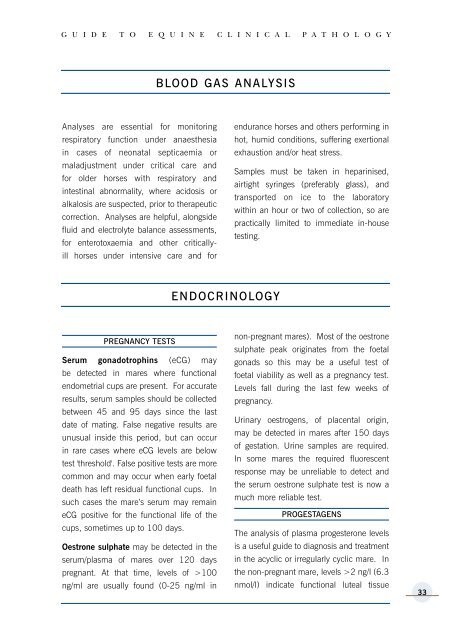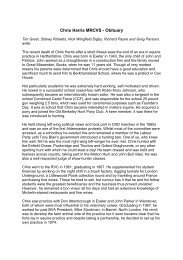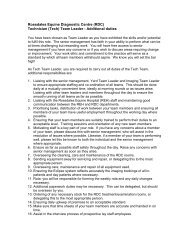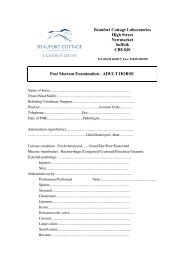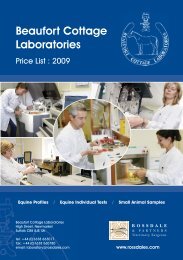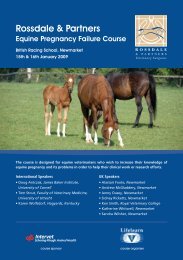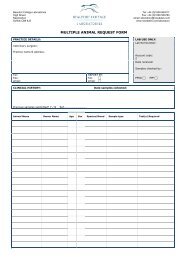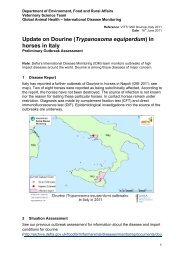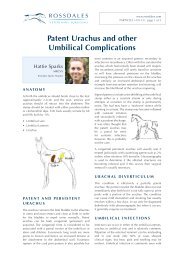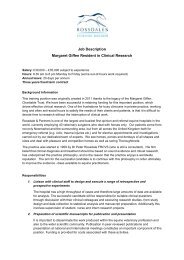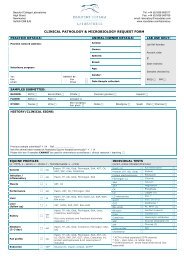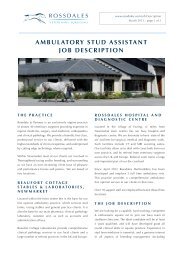EQUINE CLINICAL PATHOLOGY - Rossdale & Partners
EQUINE CLINICAL PATHOLOGY - Rossdale & Partners
EQUINE CLINICAL PATHOLOGY - Rossdale & Partners
You also want an ePaper? Increase the reach of your titles
YUMPU automatically turns print PDFs into web optimized ePapers that Google loves.
G u i d e t o e q u i n e c l i n i c a l p a t h o l o g y<br />
blood gas analysis<br />
Analyses are essential for monitoring<br />
respiratory function under anaesthesia<br />
in cases of neonatal septicaemia or<br />
maladjustment under critical care and<br />
for older horses with respiratory and<br />
intestinal abnormality, where acidosis or<br />
alkalosis are suspected, prior to therapeutic<br />
correction. Analyses are helpful, alongside<br />
fluid and electrolyte balance assessments,<br />
for enterotoxaemia and other criticallyill<br />
horses under intensive care and for<br />
endurance horses and others performing in<br />
hot, humid conditions, suffering exertional<br />
exhaustion and/or heat stress.<br />
Samples must be taken in heparinised,<br />
airtight syringes (preferably glass), and<br />
transported on ice to the laboratory<br />
within an hour or two of collection, so are<br />
practically limited to immediate in-house<br />
testing.<br />
Endocrinology<br />
Pregnancy Tests<br />
Serum gonadotrophins (eCG) may<br />
be detected in mares where functional<br />
endometrial cups are present. For accurate<br />
results, serum samples should be collected<br />
between 45 and 95 days since the last<br />
date of mating. False negative results are<br />
unusual inside this period, but can occur<br />
in rare cases where eCG levels are below<br />
test 'threshold'. False positive tests are more<br />
common and may occur when early foetal<br />
death has left residual functional cups. In<br />
such cases the mare’s serum may remain<br />
eCG positive for the functional life of the<br />
cups, sometimes up to 100 days.<br />
Oestrone sulphate may be detected in the<br />
serum/plasma of mares over 120 days<br />
pregnant. At that time, levels of >100<br />
ng/ml are usually found (0-25 ng/ml in<br />
non-pregnant mares). Most of the oestrone<br />
sulphate peak originates from the foetal<br />
gonads so this may be a useful test of<br />
foetal viability as well as a pregnancy test.<br />
Levels fall during the last few weeks of<br />
pregnancy.<br />
Urinary oestrogens, of placental origin,<br />
may be detected in mares after 150 days<br />
of gestation. Urine samples are required.<br />
In some mares the required fluorescent<br />
response may be unreliable to detect and<br />
the serum oestrone sulphate test is now a<br />
much more reliable test.<br />
Progestagens<br />
The analysis of plasma progesterone levels<br />
is a useful guide to diagnosis and treatment<br />
in the acyclic or irregularly cyclic mare. In<br />
the non-pregnant mare, levels >2 ng/l (6.3<br />
nmol/l) indicate functional luteal tissue<br />
33


